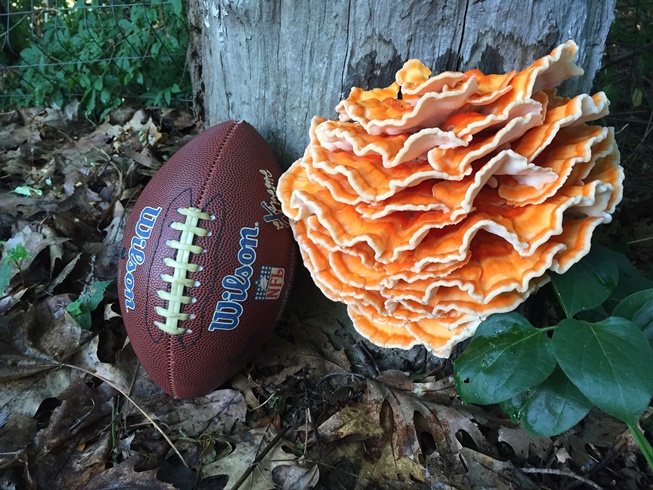The Wrack
The Wrack is the Wells Reserve blog, our collective logbook on the web.
The Wrack is the Wells Reserve blog, our collective logbook on the web.

The following was published in the Biddeford-Saco Journal Tribune Sunday edition, 8/7/2016, and Making It At Home's 8/11/2016 issue.
The orange ruffles hadn’t been there last week, but now they were impossible to miss. Overnight, it seemed, a chicken-of-the-woods had returned to roost on the old oak stump in our yard.
My family already knew we could watch birds and treehouses and lightning from our kitchen. We hadn’t realized that we could also observe a blooming fungus. Neither an animal nor a vegetable, it was nonetheless growing and ripening right in front of our eyes.
We’d first found it on the stump when we moved in three years ago. It was like a housewarming gift from our yard, and we cautiously cooked and ate it. The verdict: delicious, once we got over our nerves. But it hadn’t returned the next two summers. I felt as though we’d offended our stump in some way.
Now the chicken was back, and within a few days, it was larger than a football. “There’s a fungus among us,” I crowed to my boys. “Lunch is on the stump!”
The chicken-of-the-woods, less appetizingly known as the sulphur shelf or Laetiporus sulphureus, is the only mushroom I’m confident enough to pluck, sauté, and eat. There’s really nothing else like it, looks-wise, and it has a mild flavor and meaty texture that even our six-year-old will try.
My not-so-inner cheapskate delights in free food from the earth. Sure, we have some raised beds, but aside from seeds and tomato plants, we don’t put any money into them. Our “garden” still requires time, of course, and if you could see my carrot shame this year, you’d probably recommend additional investments. But the raspberry patch down the street, the blueberry bushes at the Wells Reserve where I work, and now, our old friend the chicken-of-the-woods: they are, to me, Mother Nature’s pantry, there for the raiding.
That said, I wouldn’t want to bet my life on the appearance of those berries and mushrooms. I’m lucky we also have a regular pantry too, stocked continuously with weekly/biweekly/daily trips to Hannaford. Otherwise, my family would starve, for many reasons.
Not the least of which is that I have no way to predict when the chicken-of-the-woods will appear. It grows sometime between July and October, depending on temperature, moisture, and a dozen other factors. The chicken-of-the-woods is no domesticated treat.
Other blooms and fruits and migrations are more reliable, but according to phenology, the study of nature’s calendar, even they are shifting nowadays. If I were an insect or a bird, I wouldn’t know when to expect food. The cycles of the “pantries” many of our local species have evolved on have gone haywire, as Schoodic Institute science coordinator Dr. Abe Miller-Rushing recently revealed at a lecture at the Wells Reserve.
Take, for instance, the highbush blueberry. At Walden Pond in the mid-19th Century, amateur naturalist, professional loafer, and keen observer Henry David Thoreau kept track of the annual blueberry blossoming, recording their appearance on May 11, 1853, and May 14, 1855. In 2012, the blueberry blossoms appeared on – no joke – April 1st. That’s six weeks earlier, in the space of six generations. Orchids, stone fruits, fish and bird arrivals: they’ve all, in our region, retreated earlier into the year, in step with our earlier springs.
Oh the timings / they are a-changing. Why? As usual, the answer is climate change. In Maine, average annual temperatures have risen by 3 degrees Fahrenheit over the past 100 years and are predicted to rise another 4 to 10 degrees by 2080. (Akin to moving to New Jersey or even North Carolina.) Maine’s annual precipitation has increased by 6 inches over the same time period and more frequent and intense rain and snow storms are expected. (Take a look at the flash flood-ravaged West Virginia and Maryland towns from the last month to see what that looks like.)
What is to be done? We’ll study the changes, of course. The Wells Reserve has been monitoring water quality, weather, and the flora and fauna in our local salt marshes for decades. We now keep track of what’s blooming in the Wells Reserve’s entrance and All-Seasons gardens, so beautifully maintained by the York County Master Gardeners. Many other concerned people, citizen scientists all, use online tools like eBird and the National Phenology Network to add to our collective knowledge of our changing times.
Along with all that science, our societies are also going to have to prepare, adapt, and even try to unwind some of these changes. We’ll also have to accept some inevitability. “Gather ye rosebuds while ye may.” And, at other times, blueberries or orange chickens.
Nik Charov is president of Laudholm Trust, the nonprofit partner of the Wells National Estuarine Research Reserve in Wells, Maine. His biweekly [uhh, more like monthly] column, “Between Two Worlds,” ventures forth from the intersection of art and science, past and present, bloom and bust. More at wellsreserve.org/twoworlds.